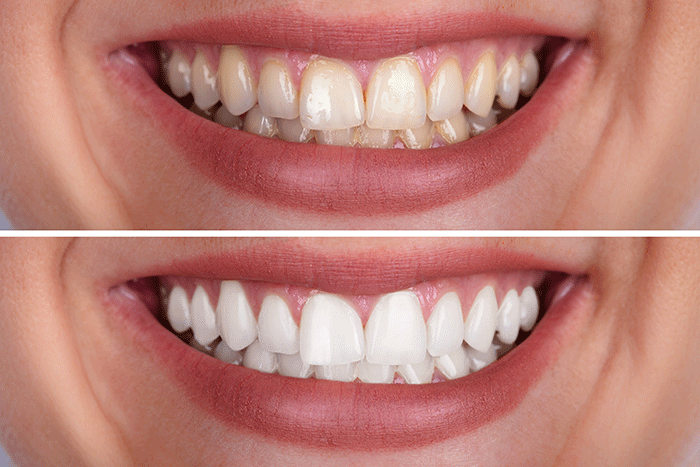Posts by designloud
How Does Gum Disease Develop?
February is National Gum Disease Awareness Month, so we’re taking a moment here to help raise awareness about an important oral health condition.
For such a seemingly small thing, gum disease is a much bigger issue than many of us realize. Nearly 2/3rds of American adults will deal with gum disease at some point in their lives. While most of the time gum disease is fairly benign, if left untreated it can result in permanent damage to the teeth including tooth loss. In addition, gum disease can exacerbate some other health problems, leading to additional complications and negative outcomes.
So how does gum disease develop, and what can we do to prevent gum disease? Let’s learn a bit more about how gum disease works and what you can do about it.
What Is Gum Disease?
Gum disease is an infection of the gum tissue or gingiva, which results from excess bacteria buildup. This generally results due to poor oral hygiene habits and poor diet, although other factors like tobacco and alcohol use can play a role. Generally speaking, the symptoms of gum disease include:
- Swollen or puffy gums, gums that are discolored dark red or purple
- Gums that feel tender when touched
- Gums that bleed easily. This may manifest as a pink-tinged toothbrush or spitting out blood after brushing or flossing.
- Bad breath
- Pus between your teeth and gums
- Loose teeth or even tooth loss
- Pain while chewing or speaking
- New spaces developing between your teeth
- Gums that pull away from your teeth
- A change in the way your teeth fit together when you bite
If left untreated, gum disease can cause serious problems, including permanent damage to the teeth, gums, and jaw. If you are experiencing any of these symptoms, it may be time to make an appointment with your dentist to pursue treatment options. They can help you understand what’s happening and suggest the right remedy.
The Development of Gum Disease
So how does gum disease develop? Naturally occurring bacteria in the mouth, if left unchecked by regular cleaning, can build up on the teeth and manifest as a sticky biolayer called plaque. As this plaque layer builds up on the teeth and under the gums, it causes further infection and irritation, which can cause the swelling, bleeding, and tenderness mentioned above. As plaque accumulates, it may become dental tartar, a thick white substance made of bacteria and their waste. This is where the serious problems begin, as gum disease–also known as gingivitis–can develop into the much more serious condition of periodontitis. Periodontitis occurs when pockets form under the gum, which is filled with bacteria, plaque, and tartar. These are potent spots for infection, which can lead to tooth loss, bone loss in the jaw, and gum loss. The damage can be permanent if left unchecked. In addition, the bacteria which cause these infections may spread to the rest of the body, which can complicate conditions such as respiratory ailments, diabetes, and some digestive disorders.
The best way to treat gum disease is prevention. A good brushing and flossing routine combined with a healthy diet is the first step. Regular visits to your dentist for exams and cleaning are another important piece of the puzzle. If you’re due for an appointment or just concerned about your oral health, make an appointment today.
Myths About Teeth Whitening
Teeth whitening is one of the most common cosmetic dental procedures and one which is growing in popularity every year. There are several reasons for this–whiter teeth and the resulting bright and shining smile can increase the patient’s confidence and quality of life. Generally speaking, teeth whitening is an easy procedure performed with minimal discomfort to the patient, and treatment can be completed with a trip or two to the dentist.
While there’s a lot to be said for teeth whitening, there are also some popular myths and misunderstandings about the procedure and how it works. Some of these myths may be off-putting to new patients, so let’s take a look at some of the myths about teeth whitening and hopefully make the procedure better understood and more user-friendly.
I can’t afford teeth whitening!
While there are a number of approaches to teeth whitening, some of which can cost thousands of dollars, in general teeth whitening procedures are far more affordable. Some insurance does cover teeth whitening, further decreasing the cost to the patient. Talk to your dentist about teeth whitening and what it might cost you for a better idea of what your individual expenses might be.
I can’t have my teeth whitened because I have too much dental work/partials/veneers/etc!
This is a common myth about teeth whitening, and it’s not as true as many folks insist that it is. While existing dental prosthetics may limit which teeth whitening treatments can be used, it doesn’t make it impossible. Your dentist might suggest a milder, multi-step treatment rather than conventional chemical bleaching. This can remove stains and discoloration without damaging your teeth or dental prosthetics.
I’m too busy!
We hear this one often, and we get it. It’s a busy time for all of us, and the demands of work, family, and your social life may leave you feeling that you just don’t have time for a teeth whitening treatment. However, this myth about teeth whitening is just that, a myth. Most teeth whitening treatments aren’t overly time-consuming and can be completed in one or two trips to the dentist’s office.
You can whiten your own teeth using acidic fruits or some other home cure!
Please do not do this, as it can damage your teeth. Acidic fruits or other home treatments eat away at the enamel outer layer of your teeth. Enamel can’t grow back, so this damage is permanent and leaves you at risk for cavities, tooth decay, or even tooth loss.
Home whitening treatments work just as well!
Home whitening treatments can work, but they’re generally messy, inconvenient, and they often deliver inconsistent results. The best course of action is to see your dentist and get a professional whitening treatment. You’ll be happier with both the process and the results!
You only need a teeth whitening treatment once!
This generally isn’t the case. While a teeth whitening treatment can last a long time, you’ll need regular cleanings and occasional follow-up teeth whitening treatments to maintain your best results.
Teeth whitening is a common, useful dental procedure that can do a great deal to improve the life of the patient in question. While there are a number of myths about teeth whitening, we hope we’ve dispelled a few of them here. If you think teeth whitening is the right choice for you, get in touch and make an appointment today!
Should I Have Teeth Whitening Done or Porcelain Veneers?
In an ideal world, our smiles would remain bright, shiny, and healthy throughout our lifetimes. In practice, teeth become discolored. This is a common issue, affects most adults over the course of their lives, and it can occur for any of a variety of reasons. There’s no reason to be ashamed of discolored teeth, but you may want to correct that condition for professional or personal reasons. So, what’s the best way to go about it?
Two of the most common approaches to correcting discolored teeth are teeth whitening and dental veneers. Both have their advantages, so it will depend on your situation, your overall goals for your appearance and your oral health, and how much time you want to invest in addressing discolored teeth. Let’s learn a bit more about discoloration, what causes it, and what both teeth whitening and veneers have in common.
What Causes Discoloration?
There are a host of potential causes for discolored teeth. If you notice the color of your teeth changing, particularly changing suddenly or unexpectedly, you should consult your dentist for an exam to address the issue. In general, some of the more common causes of discoloration are:
- Food and drink are the most likely culprit for most people. Some foods are prone to staining teeth an off-color; red wine, coffee, and colas/sodas are common causes of discolored teeth. Some fruits and vegetables can do the same, as can some chocolates and candies.
- Tobacco use is bad for all aspects of health, particularly oral health, and it is a prime cause of discolored teeth. Both smoking and chewing tobacco can discolor the teeth.
- Poor dental hygiene is another problem that may lead to discolored teeth. Without regular and effective brushing and flossing–combined with a good diet and regular dental exams and cleanings–your teeth will likely become discolored or yellowed.
- Some medical conditions can lead to discolored teeth. Some diseases may cause the tooth to become yellowed. Some medical treatments, including certain medications, radiation treatments, and chemotherapy, may lead to discoloration. Your doctor and dentist can tell you more about how this may affect you.
- Genetics and aging may also be to blame. Some of us are just more prone to discolored teeth. Likewise, teeth may naturally yellow as we get older.
Teeth Whitening vs Dental Veneers
Teeth whitening and dental veneers work differently in how they correct discolored teeth. Let’s take a look at teeth whitening first.
Teeth whitening works by using a chemical agent to bleach the teeth to the desired color and shine. As with laundry bleach, the chemicals used in teeth whitening treatments work by removing stains and discolorations. Generally, this can be accomplished in one dentist visit. Your dentist will apply the whitening agent to your teeth, let it sit for the appropriate amount of time, and then remove it and clean your teeth. You’ll be left with nice, shiny, clean teeth. While this is fairly quick and easy, it’s not necessarily a permanent solution. You may need to return to the dentist for whitening treatments periodically.
Dental veneers are a permanent prosthetic solution. As the name suggests, your dentist will craft thin porcelain or ceramic veneer to be affixed to the outer side of the tooth or teeth in question. This is a permanent treatment–the tooth or teeth may need to be reshaped in order to accept the veneer. While the veneer may be colored any way you want and requires no more care than your natural teeth, veneers may involve more than one office visit, are more expensive, and again do involve permanently altering your natural teeth.
So what’s the best choice? That depends on you and your situation–your overall health and overall goals are the key consideration. Your dentist can help you decide by explaining what both teeth whitening and dental veneers will mean for you and then guide you to the right choice. If you’re interested in either teeth whitening or dental veneers, get in touch today and make an appointment! Our experienced and friendly staff will explain both and what you need to know about them.
“Mask Mouth”: Stress Related Oral Health Issues and COVID-19
It’s no secret that the last year of our lives has brought us face to face with some serious health challenges. The COVID pandemic forced vast and lasting changes onto many of our lives, and the issue isn’t resolved yet. As we all work to find ways to social distance, mask, and keep each other safe, every aspect of health care has had to adapt to our new normal. Dentist offices around the world are working to find ways to provide high-quality care in the safest possible way. As we continue our journey through the pandemic, dental providers are also noticing some other issues related to COVID. In particular “mask mouth” and other stress-related oral health issues are on the rise. By knowing what they are and what causes them, we can all do our part in the prevention and help maintain our oral health.
“Mask Mouth”, as it has come to be called, is an interesting new oral health challenge arising from the widespread use of masking as a means of disease control during the pandemic. Essentially, mask wearers subconsciously become accustomed to breathing through their mouths while masked. This small change of habit can lead to dry mouth, a condition where there’s just not enough saliva. A dry mouth can contribute to gum disease and even lead to tooth damage or tooth loss if left unabated. The solution is simple, however: stay in the habit of breathing through your nose even while wearing a mask. It’s fairly easy to do and builds a good habit and good oral health. Likewise, drinking more water helps your body stay hydrated and contributes to good saliva flow, which in turn keeps your teeth healthy.
Another COVID-related oral health issue is the sharp rise in stress-related complications. In brief, dentists everywhere are seeing a rise in the number of patients reporting everything from sore jaws to teeth grinding and even damaged/chipped teeth from grinding or jaw clenching. These can be serious problems; tooth loss may result from any of these causes if they’re left untreated. If you notice any of the symptoms of teeth grinding or jaw clenching: sore jaw, headaches, the tension in the face or neck, or worn/damaged teeth, you should tell your dentist right away. A number of solutions exist, ranging from an over-the-counter mouth guard to protect the teeth at night to medications for stress and muscle tension to therapy to get at the root cause of the issue. The important thing is to address the problem quickly: ignoring it and hoping it will go away on its own only makes things worse.
The COVID pandemic is an ongoing challenge for all of us, and in these busy and difficult times, it can be easy to forget about oral hygiene and tooth care. The fact is that these things are more important than ever. So take care of your teeth, address the problems before they arise, and keep making regular appointments with your dentist for exams and cleanings. When things get back to normal, you’ll be glad that you did.




